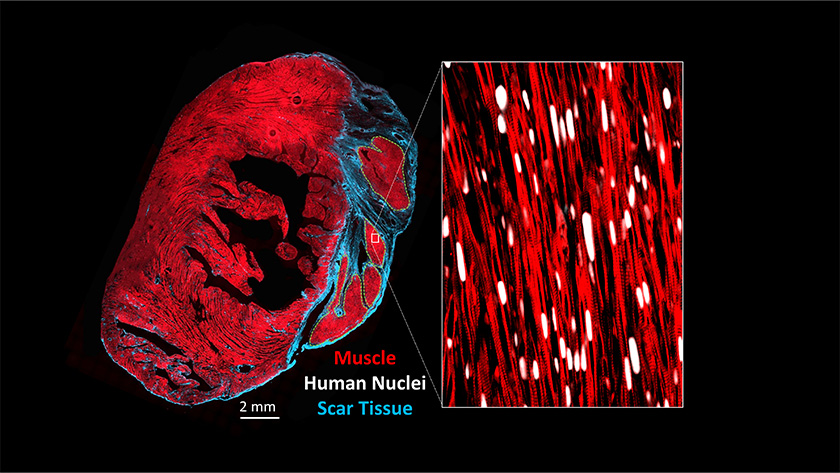Dr. Wahiba Dhahri, (L), former postdoctoral fellow and first author of the study, and Dr. Michael Laflamme, senior author of the study and Senior Scientist at UHN’s McEwen Stem Cell Institute. (Photo: UHN StRIDe Team)
A recent study from researchers at University Health Network’s McEwen Stem Cell Institute reveals a new approach that could be used to treat the damage that typically results from a heart attack.
“Right now, the only way we can replace the lost muscle after a heart attack is to give the person an entirely new heart,” says the senior author of the study and Senior Scientist Dr. Michael Laflamme. “But there are not enough donor hearts to go around.
“An emerging approach known as cell therapy involves transplanting new muscle cells into the heart at the site of the damage. While it is not yet clinically effective, our findings are pushing us closer to that goal.”
The team used heart muscle cells derived from stem cells. Typically, these heart muscle cells have young or immature properties similar to those found in the developing fetal heart. Due to technical difficulties in preparing more mature cells, previous studies have relied on using immature heart muscle cells during cell transplantation.
A technical discovery led by Dr. Laflamme’s postdoctoral fellow, Dr. Wahiba Dhahri, revealed a way to produce heart muscle cells in the lab that are more similar to those found in an adult heart. The research team tested these new cells in an experimental model of cell therapy for heart disease, and found that they led to better outcomes with no unwanted side effects such as arrhythmia, or irregular heartbeat, which has the potential to be fatal.
To coax heart cells to mature, Dr. Dhahri used films of material called polydimethylsiloxane (PDMS), which is often used in bioengineering. She used a common lab tool called a roller bottle and lined the inside of it with PDMS in order to multiply and grow the heart cells on.
This approach enabled the team to grow the necessary number of cells needed for the cell transplant procedure – but without the high costs or complexity that are typically needed to manufacture mature cells.

The team used then advanced microscope technology to first show that mature cells successfully implanted and integrated electrically into the damaged areas. They then looked at the physical structure of transplanted cells and found mature cells more closely resemble and beat with a pattern that is more similar to healthy adult heart muscle cells.
Importantly, recipient hearts of the mature cells also showed substantially better recovery of contractile function, or pump function, than did recipient hearts of immature cells.
“Our study has shown the benefits of transplanting mature cells in injured hearts,” says Dr. Dhahri. “This method will have an impact, not only on clinical production with economically and technically feasible platforms, but also on the enhanced quality and safety of the product.”
Dr. Laflamme explains the next step will be to test this approach in preclinical models that more closely resemble human hearts.
“We are optimistic we can develop a better cell product that is more likely to make it into the clinic and improve treatment options for individuals damaged hearts,” Dr. Laflamme says.
This work was supported by the McEwen Stem Cell Institute, the Peter Munk Cardiac Centre, the Stem Cell Network and the University of Toronto’s Medicine by Design initiative, which receives funding from the Canada First Research Excellence Fund initiative. Dr. Dhahri was supported by a Mitacs Elevate Postdoctoral Fellowship. Dr. Laflamme is an Associate Professor in the Department of Laboratory Medicine & Pathobiology at the University of Toronto. Dr. Laflamme is the Robert McEwen Chair in Cardiac Regenerative Medicine at UHN and holds a Tier I Canada Research Chair in Cardiovascular Regenerative Medicine.
